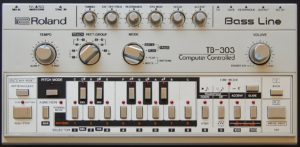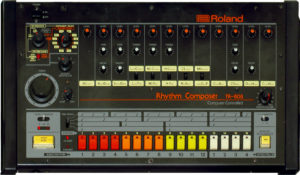Ikutaro Kakehashi died on Saturday at the age of 87. A check check of the Interwebz doesn’t reveal the cause of his death, and he was Japanese – but he has to get a Great British Strokes-shaped post.
Y’see, this…

[For more repetitive beats, check out the Apoplexy Tiny Letter.]
Well, not just the 303. As well as that bass synth, the founder of Roland Corporation was the leader of the team that created the TR-808 drum machine and its successor, the 909, which added MIDI control. In doing all this he might be seen as the creator of the sound behind house music, acid house, trance, and much of hip-hop.
Not that it was intentional.

The 303 was originally marketed to guitarists for bass accompaniment while practicing alone. Production lasted approximately 18 months, resulting in only 10,000 units. But in the mid- to late-1980s DJs and electronic musicians in Chicago found a use for the machine in the context of the newly developing house music genre. (Thanks, Ian Wiki!)
In fact in this interview, the boss of Newcastle-based acid record label Acid Waxa says that Roland’s Head of R&D, Tadao Kikumoto, wanted to destroy the TB-303 because it was not produced with the intention of black and brown people using it to invent wiggy dance music in Chicago and India. I’ve no idea whether there’s anything to that.

Even before the house revolution, the 303 and its cousins had been involved in a string of memorable and records. The NME’s list of best songs made on Roland devices includes Marvin Gaye’s Sexual Healing. In its ubiquity, with that awesome voice, the aggressively synthetic backing isn’t the first thing I notice, but check the cut again. And this pen picture:
Tightly-wound, tap-tap electronic percussion became cool thanks to Marvin Gaye…. [T]his was a daring, ultra-experimental move that quickly birthed Gaye’s most successful song… Just when Kakehashi’s device was beginning to look like an unpopular, unloved mistake, Gaye started the 808 revolution.
The Guardian’s open thread on what songs made best use of the 303, 808, and 909 from 2014 includes Sexual Healing, and this cut from stroke blog hero, Edwin Collins and Orange Juice
Rip it Up was the first chart song in the UK to feature a 303 and again, listening to it fresh, it it must have sounded revolutionary. Squelchy. And, look at that! Was it recorded in a TARDIS?!
As Fatboy Slim would later note, Everybody Needs a 303. And that track couldn’t be much further from the idea of a guitarhead noodling away to a bass accompaniment. It’s funny how things can adapt in ways that an original event couldn’t possibly predict. While I’m thinking about the Clint Mansell-soundtracked Ghost in the Shell, this tweet by the brilliantly-monikered @siliconglen leads to an interesting piece on how the obsolescence of the mobile phone will change everything:
The smartphone is eventually going to die, and then things are going to get really crazy https://t.co/yAVsaAY9v2 via @BIUK_Tech
— Craig Cockburn (@siliconglen) April 6, 2017
I could note how a massive haemorrhagic stroke can change things in the most unexpected ways and lead to unexpected outcomes and insights.
But that would be a bit too on-the-nose, wouldn’t it?





Call me a Luddite, but I don’t like any of the songs on the NME list (Psycho Killer is better with Chris on Drums, Tina on Bass), nor do I like many musicians who use synthesized drum and bass sounds. I’ve always placed a high premium on human beings playing instruments, especially for the rhythm section. So yes, I feel very out of place in the music world of today. 🙁
(One exception: The Sisters of Mercy, featuring Doktor Avalanche. Saw them live a couple of times in the aughts. Was hard to watch three guys trying to keep in time with the good Doktor, even though they were mostly successful.)
I obsessed about the nature of rhythm dynamics and automation recently. The four folk dances, world premiere at interrobang on may 26, I wrote have that idea as one of the core composition concepts.
Nowadays I can get more organic rhythm with a drum designer than I can with a drum set. But I’m a pretty mediocre drummer so…
I think it’s hard not to be obsessed by these sorts of things at the moment. I mean, there’s a million items of stroke news this week, but what I want to write about is automation and VR and robots. And as with some of the songs in this blog post, going back to Four Folk Dances – I’m planning to go hard on my Prof Paul listening tonight – with a little knowledge about the background will be rewarding, I think.
Does the body rule the mind, or does the mind rule the body? To quote the great (?!) Mancunian Miserablist, ‘I dunno.’
P.S. Pretty mediocre? You’re barely the second best drummer in The Beatles.
You’re a Luddite. Now, call me an ambulance.
Nice Goth pandering on the Sisters bit, though. I’ll have told you the story before about Eldritch coming on stage in a billowing bright yellow silk shirt and bellowing to the infuriated hardcore Goth audience, ‘We’re The Sisters of Mercy,and we’re A ROCK AND ROLL BAND’?
Aaaanyway. I think I feel where you’re coming from. But it’s odd, I’d never particularly think of Let’s Get It On or Rip It Up as synthesised songs. They’re just songs. But then I listen a bit more closely, and hear the sounds. And as long-suffering readers of the blog will know, I love sounds.
http://www.loopmasters.com/articles/2627-Create-a-Roland-303-Clone-With-Logic-s-ES1-Synth
And I do have a complete 808 sample set.
“Yes glitchy everything’s gonna be wild” time maybe?
Of course you do.
And that would be awesome. Can we double A-side it with an acoustic cover of The Sisters covering Gimme Shelter for Marcelo?